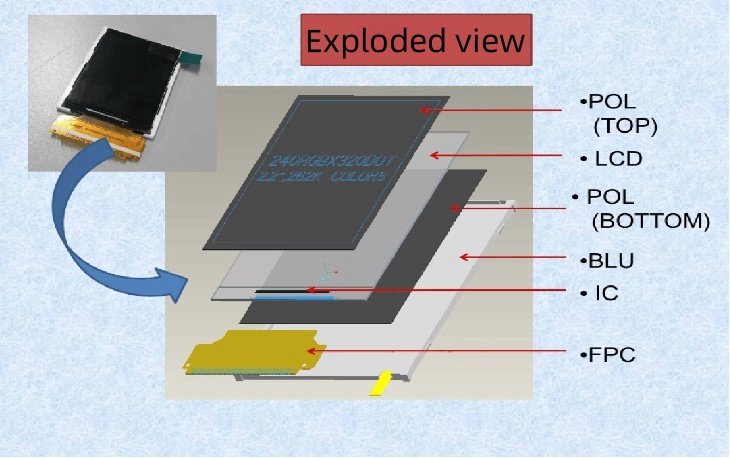TFT-LCD (Thin-Film Transistor Liquid Crystal Display) is the fundamental engineering behind the screens we use every day. From computer monitors and laptops to televisions and tablets, ce “active-matrix” technology has been the dominant force in the display industry for decades.
But what exactly is a TFT-LCD display, how does it work, and why is it still so prevalent? This comprehensive guide will break down the technology, its advantages, and its role in the modern display landscape.
How Does a TFT-LCD Work? A Step-by-Step Breakdown
A TFT-LCD is essentially a sandwich of sophisticated layers, each with a critical role. The name gives away its two core components:
The Liquid Crystal Display (LCD): Liquid crystals are substances that can flow like a liquid but have molecules that can be oriented like a crystal. They can twist and untwist to control the passage of light when an electric field is applied.
The Thin-Film Transistor (TFT) Array: This is the “brain” behind each pixel. A TFT is a tiny switch for each sub-pixel (rouge, vert, or blue) on the glass substrate. This matrix of transistors allows for precise, active control over each individual pixel, resulting in a sharper and more responsive image compared to older, passive technologies.
Here’s the simplified process of how a TFT-LCD creates an image:
Rétroéclairage: LED lights at the edge or behind the panel provide a uniform source of white light.
First Polarizer: This light passes through a polarizing filter, which aligns the light waves in a single direction.
Liquid Crystal Shuttering: The polarized light then reaches the liquid crystal layer. The TFTs apply a specific voltage to each pixel, causing the liquid crystals to twist. This twisting action acts like a shutter, controlling how much light can pass through.
Color Filter: The light then hits the color filter layer, which contains red, vert, and blue sub-pixels. By varying the intensity of light through each sub-pixel, millions of colors can be created.
Second Polarizer: Finally, the light passes through a second polarizing filter. The combination of the liquid crystal twist and this final filter determines the final brightness and color of the pixel that reaches your eye.
Main Types of TFT-LCD Panels: TN vs. IPS vs. VA
Not all TFT-LCDs are created equal. The way the liquid crystals are aligned defines the panel type, each with its own strengths:
TN (Twisted Nematic) Panels:
Pros: Fast response times, low cost.
Cons: Poor viewing angles, weaker color reproduction.
Best for: Competitive gaming where every millisecond counts.
IPS (Commutation dans le plan) Panels:
Pros: Excellent color accuracy, superior viewing angles.
Cons: Slightly higher cost, potentially slower response times than TN (though modern IPS is very fast).
Best for: Graphic design, photo editing, and premium monitors and smartphones where color fidelity is critical.
VA (Vertical Alignment) Panels:
Pros: High contrast ratios, deep blacks, good color reproduction.
Cons: Slower response times can lead to “ghosting” in fast-paced games.
Best for: Home theater televisions and general media consumption where contrast is key.
TFT-LCD vs. OLED: Key Advantages and Limitations
While newer technologies like OLED (Organic Light-Emitting Diode) have emerged, TFT-LCD remains highly competitive due to several key factors.
Advantages of TFT-LCD:
Proven Technology & Cost-Effectiveness: Mass-produced for years, making it highly affordable, especially for larger screens.
Long Lifespan: The LED backlight and LCD materials have a very long operational life.
High Brightness: Excellent for use in brightly lit rooms and outdoors.
High Resolution: Easily scales to 4K, 8K, and beyond, making it ideal for high-detail displays.
Limitations of TFT-LCD:
Limited Native Contrast: Since the backlight is always on, achieving true black is difficult, as some light always leaks through.
Power Consumption: Generally less efficient than OLED when displaying dark content because the backlight is always on.
Épaisseur: Nécessite un rétroéclairage, making it inherently thicker than self-emissive technologies like OLED.
The Future of TFT-LCD: Innovation with Mini-LED
The TFT-LCD industry is not standing still. The most significant innovation is Mini-LED backlighting.
This technology replaces the traditional backlight with tens of thousands of microscopic LEDs. This allows for precise local dimming, where specific zones of the backlight can be turned off completely while others remain bright. The result? Drastically improved contrast ratios that can rival OLED, without sacrificing the classic benefits of LCD, such as high brightness and no risk of burn-in.
This makes advanced TFT-LCDs with Mini-LED a top-tier choice for premium televisions and professional monitors.
Conclusion: A Lasting Legacy and a Bright Future
TFT-LCD technology laid the foundation for the flat-panel revolution, enabling the slim, energy-efficient devices we now take for granted. Its combination of performance, fiabilité, and affordability has made visual technology accessible to billions.
While the display world continues to evolve with OLED and MicroLED, TFT-LCD, especially when enhanced with Mini-LED, continues to be a robust, high-performance, and cost-effective solution. It will remain a cornerstone of the global display market for years to come, powering everything from budget smartphones to cutting-edge 8K TVs.


